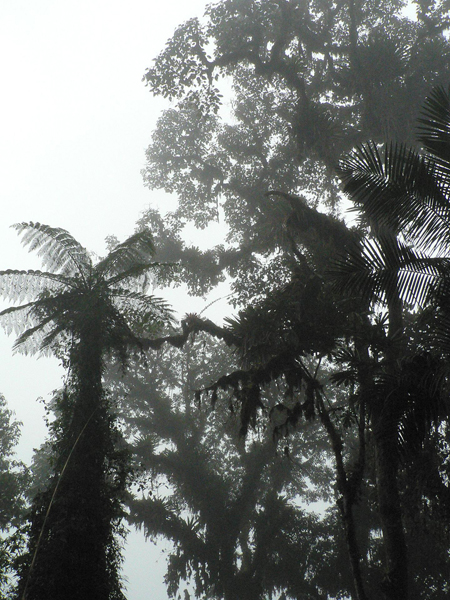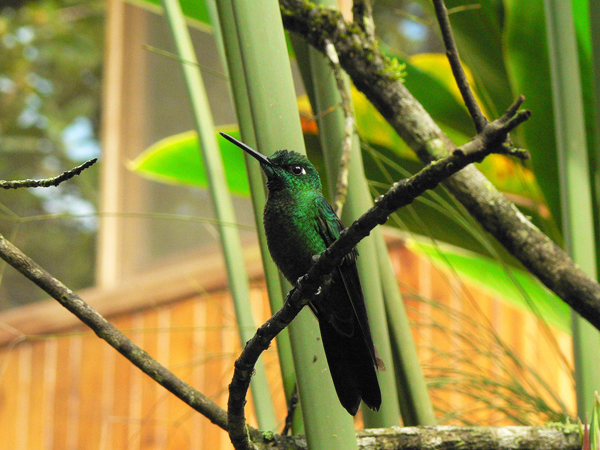The cloud forests and hummingbirds of Ecuador
The bus journey to Mindo winds up and out of the high, dry valley in which Quito sits between volcanic peaks, and then down into the wet, lush cloud forest on the western slopes of the Andes. This is one of the most biodiverse places on earth, within the Tumbes-Chocó-Magdalena hotspot, and recognized as an Important Bird Area by BirdLife International. Mindo is a quiet little place, surrounded by forested hills which often disappear into the clouds. We arrived in the rain at dusk, and made our way along virtually deserted streets to our accommodation at Cabañas Armonia (http://www.birdingmindo.com/armonia.php). This is an orchid garden masquerading as jungle, and we were led to our little cabin, one of a handful tucked away amongst the plants. After the dry, thin air of Quito, the humidity, the smell of the wet vegetation, and the chorus of frogs, were wonderful.
The family that owns Cabañas Armonia maintains feeders for hummingbirds, and these tiny birds drink litres of sugar water between them every day. Watching and listening to them whirr, chirp and squeak is hypnotic, and catching them with your camera becomes an endless challenge.
Highlights of our stay at Cabañas Armonia included lazy birdwatching from our private hammock, with toucans and hummingbirds among the many species that regularly passed by. The garden is home to some 200 species of orchid, some so small that a magnifying glass is needed to appreciate their beauty, others unmissable in their extravagance. Wandering amongst them was a fascinating introduction to their variety and diversity. We also went for walks along the quiet lanes that lead out of town, which took us through verdant green valleys, coffee plantations, and lush vegetation, and rewarded us with sightings of gaudy tanagers, toucans and aracaris, and a stunning quetzal.
On our way back to Quito we visited Bellavista Cloud Forest Reserve (http://www.bellavistacloudforest.com/), 1000m higher up the mountains than Mindo. We got off the bus at a small village called Nanegalito, and were quickly approached by the driver of a pick-up truck taxi who drove us up the steep and winding single track lane to Bellavista lodge. The lodge sits within a private reserve that protects 700 hectares of cloud forest. There is an extensive trail system, comfortable accommodation, excellent food, and it is renowned for its birding. Such luxury and biodiversity meant that the lodge itself was way beyond our tight backpacker budget, but Bellavista is a rarity, offering affordable accommodation, alongside its more luxurious options, for travelers on a budget who are happy with a more rustic experience. It is possible to stay and explore the reserve on a shoestring: a small research station doubles as basic hostel accommodation, and incredibly, very few people make use of this. This is a big shame because the forest around Bellavista is like nothing we had seen before – huge tree ferns, and trees dripping with multiple layers of vegetation, shrouded in ethereal mist and cloud which sometimes broke to reveal the precipitous view down to the valleys below. The trails were easy to follow, and took us up and down steep ravines to hidden streams.
The research station accommodation was basic, but we had a warm bed and a hot shower, and pots and pans to cook with over a gas stove. Fellow residents included scientists from the United States, their Ecuadorian research assistants, a couple of temporarily captive birds that were the focus of their studies, a sink-full of beetles collected for a small project, and a noisy mouse who helped itself to a chunk of banana in the kitchen. The captive birds were, of course, early risers and woke us from their room next to ours with an ear-splitting duet at dawn. Electricity is from a generator that is only run for a few hours a day, and as it is virtually on the equator it got dark about 6pm. Evenings were spent quietly by the light of candles and headtorches, listening to the myriad noises coming from the forest.





